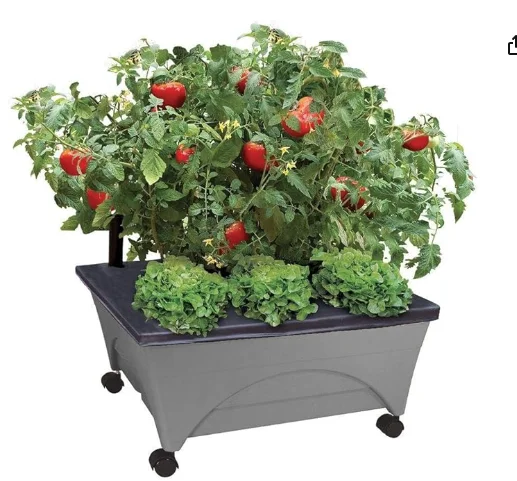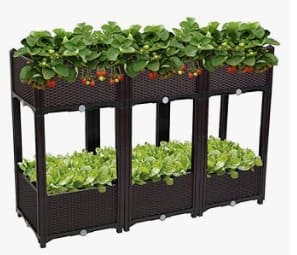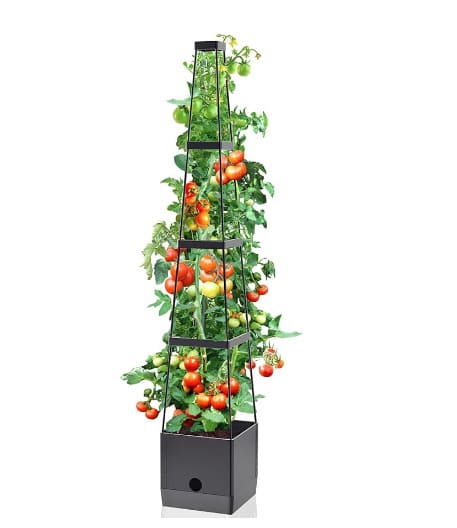Self-Watering Vertical Garden Planters: A Comprehensive Overview

Introduction
If you love gardening or want to start growing plants, self-watering vertical garden planters are a great way to bring nature inside your home.
This article covers the advantages, how to set them up, do-it-yourself ideas, choosing plants, and more.
Let’s discover self-watering vertical garden planters together!
What are Self-Watering Vertical Garden Planters?
How do Self-Watering Vertical Garden Planters Work?
Self-watering vertical garden planters work by using a wicking system to provide the roots of the plants with the water they need.
The planter consists of a water reservoir at the base, a wicking mechanism that draws water from the reservoir, and a soil bed where the plants are grown.
As the soil dries out, the wicking mechanism draws water up from the reservoir, delivering it directly to the plant roots.
This continual moisture supply helps to prevent overwatering and ensures that the plants receive consistent hydration.

Self-watering Pots
See more self-watering pots like these:
Benefits of Using Self-Watering Vertical Garden Planters
Self-watering vertical garden planters offer numerous advantages, making them an appealing option for gardening enthusiasts. Here are some key benefits of using self-watering vertical garden planters:
- Efficient Water Usage: These planters are designed to conserve water by delivering it directly to the plant roots, minimizing evaporation and water wastage.
- Convenient Maintenance: The self-watering system reduces the frequency of watering, making it easier to maintain the garden without constant attention.
- Optimal Moisture Levels: The built-in reservoir maintains consistent moisture levels, ensuring that plants receive the required hydration for healthy growth.
- Enhanced Plant Health: By providing a consistent water supply, self-watering planters promote healthier and more vibrant plant growth.
- Space-Saving Design: Vertical garden planters make efficient use of space, allowing for gardening in limited areas such as balconies, patios, or small outdoor spaces.
- Reduced Weeding and Pests: Elevated planters can help deter weeds and minimize pests, contributing to a cleaner and more enjoyable gardening experience.
These benefits collectively make self-watering vertical garden planters a practical and attractive choice for cultivating plants in various settings, including urban environments and small living spaces.
Choosing the Right Self-Watering Vertical Garden Planter
Size and Capacity
The size and capacity of a self-watering vertical garden planter are important considerations when choosing the right one for your space.
Here are some key points to keep in mind:
- Size: The size of the planter should align with the available space in your home or garden. Consider the dimensions of the planter and ensure that it fits comfortably in the chosen spot.
- Capacity: The capacity refers to the amount of soil and water the planter can hold. A larger capacity allows for a greater variety of plants and reduces the frequency of watering.
When assessing the size and capacity, it’s essential to think about the types of plants you intend to grow and the available space for the planter. Consider the following factors:
- Height and depth requirements of different plants.
- Water retention capabilities of the soil mix.
- The duration between water refills is suitable for your lifestyle.
Material and Durability
Choosing the right material for your self-watering vertical garden planter is crucial for its longevity and performance.
Plastic: If you are looking for a lightweight and affordable option, consider plastic planters. They are versatile and come in various colors and designs.
Wood: Wooden planters add a natural and rustic charm to the garden. They are durable and can be stained or painted to complement the surroundings.
Metal: Metal planters are sleek and modern, with excellent durability. They are suitable for contemporary garden designs.
When considering durability, it’s essential to factor in the weather conditions in your area. For instance, if you live in a windy area, a heavy metal planter may be more suitable than a lightweight plastic one.
Additionally, some materials may require more maintenance than others.
Special Features to Consider
- Adjustable Watering System: Look for a planter with an adjustable watering system that allows you to control the water flow to each level of the planter.
- Overflow System: A good self-watering planter should have an overflow system to prevent waterlogging and root rot.
- Integrated Water Level Indicator: Consider a planter with a built-in water level indicator to easily monitor the water level without having to guess or check manually.
- Modular Design: Opt for a modular design that enables you to expand the planter vertically or horizontally to suit your space and needs.
- UV-Resistant Material: Choose a planter made of UV-resistant material to ensure durability and longevity, especially if it will be exposed to sunlight.
Setting Up a Self-Watering Vertical Garden Planter
Location and Sunlight Requirements
When setting up a self-watering vertical garden planter, the location and sunlight requirements are crucial factors to consider.
The amount of sunlight your plants receive can make or break their growth and overall health.
Here’s a detailed guide to understanding the location and sunlight requirements for your vertical garden planter:
It’s essential to know the sunlight preferences of the plants you intend to grow.
Some plants thrive in full sunlight, while others prefer partial shade. Consider the following sunlight recommendations for common vertical garden plants:
- Full Sun Plants: Examples of plants that thrive in full sun include cherry tomatoes, basil, and peppers. These plants typically require at least 6-8 hours of direct sunlight per day.
- Partial Sun/Partial Shade Plants: Plants like lettuce, spinach, and Swiss chard are suitable for locations with partial sun or partial shade. They can thrive with 3-6 hours of sunlight per day.
- Shade-Loving Plants: Certain plants, such as hostas, ferns, and impatiens, prefer shaded areas with minimal direct sunlight. These plants are ideal for creating lush and vibrant greenery in shaded spots.
By carefully assessing and addressing the location and sunlight requirements, you can create an ideal environment for your self-watering vertical garden planter, nurturing healthy and thriving plants.
Plant Selection and Arrangement
When setting up a self-watering vertical garden planter, the selection and arrangement of plants are crucial to ensure a thriving and visually appealing garden.
Here are some key considerations to keep in mind:
- Plant Variety: Choose a diverse range of plants, including leafy greens, herbs, and colorful flowers. This variety not only adds visual interest but also creates a more balanced ecosystem within the planter.
- Growth Patterns: Consider the growth habits of the selected plants, such as their height, spread, and root structure. Taller plants should be placed towards the back or center of the planter while trailing or cascading plants can be positioned along the edges to create a cascading effect.
- Companion Planting: Select plant combinations that offer mutual benefits, such as repelling pests, attracting beneficial insects, or enhancing overall growth. For example, planting marigolds alongside vegetables can help deter common garden pests.
- Light and Water Requirements: Group plants with similar light and water needs together to ensure proper care and maintenance. Consider the location of the planter and the amount of sunlight it receives throughout the day.
DIY Self-Watering Vertical Garden Planters
Materials and Tools Needed
- Vertical garden planter boxes
- Drill and screws
- Water reservoir containers
- Watering tube or pipe
- Soil and compost mix
- Plants and seeds
- Watering can
- Gardening gloves
Step-by-Step Guide
- Choose a Location: Select a suitable location for your DIY self-watering vertical garden planter based on sunlight and accessibility.
- Gather Materials: Collect all the necessary materials and tools needed for the construction, including the planter boxes, irrigation system, soil, and plants.
- Install the Planter Boxes: Attach the planter boxes to the wall or frame according to the instructions provided.
- Connect the Irrigation System: Assemble and install the self-watering irrigation system, ensuring it is properly connected and functional.
- Fill with Soil: Fill the planter boxes with the appropriate soil mix, leaving space for the plants and water reservoir.
- Plant Selection and Placement: Choose suitable plants and arrange them in the planter boxes, considering their growth requirements and positioning.
- Add Water: Fill the reservoir with water, allowing the system to self-regulate and provide water to the plants as needed.
- Maintenance and Monitoring: Regularly monitor the planter boxes for water levels, plant health, and any required maintenance.
Best Plants for Self-Watering Vertical Garden Planters
Vegetables and Herbs
When it comes to self-watering vertical garden planters, there are a wide variety of vegetables and herbs that thrive in this setup.
These plants not only provide fresh and organic produce but also contribute to the picturesque appeal of the garden.
Let’s explore some of the best vegetables and herbs suited for self-watering vertical garden planters:
- Tomatoes: Known for their versatility and rich flavor, tomatoes are excellent candidates for vertical gardening. They come in various sizes and colors, adding visual interest to the garden.
- Basil: With its fragrant leaves and pleasant aroma, basil is perfect for growing in vertical planters. It thrives in well-drained soil and requires regular watering, making it ideal for self-watering planters.
- Spinach: This nutritious leafy green is well-suited for vertical gardening. It can be grown in compact spaces and enjoys consistent moisture, which is easily achieved with self-watering planters.
Flowering Plants
Flowering plants are a beautiful addition to any self-watering vertical garden planter. They not only provide aesthetic appeal but also attract pollinators such as bees and butterflies. Here are some popular flowering plants that thrive in vertical garden planters:
- Roses
- Petunias
- Geraniums
- Verbena
When choosing flowering plants for your vertical garden, consider the sunlight and water requirements of each plant.
Some flowering plants require full sun, while others prefer partial shade. Additionally, it’s important to select plants with similar water needs when planting them together in a self-watering vertical garden planter.
Furthermore, incorporating a variety of colors and textures can make your vertical garden visually captivating. Mixing different flowering plants with contrasting colors and shapes will create a stunning display.
In Conclusion
Thank you for joining us on this journey to learn about self-watering vertical garden planters. I hope you have some great ideas and motivation to start your own gardening projects.
By choosing the right planter, setting it up carefully, and adding your creative touch, you can turn your living area into a beautiful urban garden.
Explore the joys of vertical gardening and bring nature’s beauty into your surroundings!


